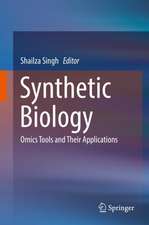Engineering Genetic Circuits: Chapman & Hall/CRC Computational Biology Series
Autor Chris J. Myersen Limba Engleză Hardback – 14 iul 2009
Takes a Clear and Systematic Engineering Approach to Systems Biology
Focusing on genetic regulatory networks, Engineering Genetic Circuits presents the modeling, analysis, and design methods for systems biology. It discusses how to examine experimental data to learn about mathematical models, develop efficient abstraction and simulation methods to analyze these models, and use analytical methods to guide the design of new circuits.
After reviewing the basic molecular biology and biochemistry principles needed to understand genetic circuits, the book describes modern experimental techniques and methods for discovering genetic circuit models from the data generated by experiments. The next four chapters present state-of-the-art methods for analyzing these genetic circuit models. The final chapter explores how researchers are beginning to use analytical methods to design synthetic genetic circuits.
This text clearly shows how the success of systems biology depends on collaborations between engineers and biologists. From biomolecular observations to mathematical models to circuit design, it provides essential information on genetic circuits and engineering techniques that can be used to study biological systems.
Din seria Chapman & Hall/CRC Computational Biology Series
-
 Preț: 361.62 lei
Preț: 361.62 lei -
 Preț: 370.11 lei
Preț: 370.11 lei -
 Preț: 357.17 lei
Preț: 357.17 lei - 8%
 Preț: 528.22 lei
Preț: 528.22 lei -
 Preț: 357.23 lei
Preț: 357.23 lei - 20%
 Preț: 389.57 lei
Preț: 389.57 lei - 9%
 Preț: 643.23 lei
Preț: 643.23 lei - 20%
 Preț: 526.41 lei
Preț: 526.41 lei -
 Preț: 357.70 lei
Preț: 357.70 lei -
 Preț: 350.06 lei
Preț: 350.06 lei - 9%
 Preț: 688.53 lei
Preț: 688.53 lei - 8%
 Preț: 407.02 lei
Preț: 407.02 lei - 8%
 Preț: 461.00 lei
Preț: 461.00 lei - 15%
 Preț: 699.14 lei
Preț: 699.14 lei - 22%
 Preț: 376.15 lei
Preț: 376.15 lei - 12%
 Preț: 305.97 lei
Preț: 305.97 lei -
 Preț: 422.44 lei
Preț: 422.44 lei - 5%
 Preț: 301.09 lei
Preț: 301.09 lei - 24%
 Preț: 702.77 lei
Preț: 702.77 lei - 15%
 Preț: 469.19 lei
Preț: 469.19 lei - 24%
 Preț: 512.37 lei
Preț: 512.37 lei - 15%
 Preț: 534.18 lei
Preț: 534.18 lei - 15%
 Preț: 682.06 lei
Preț: 682.06 lei -
 Preț: 421.63 lei
Preț: 421.63 lei - 21%
 Preț: 1023.71 lei
Preț: 1023.71 lei -
 Preț: 434.25 lei
Preț: 434.25 lei - 25%
 Preț: 529.77 lei
Preț: 529.77 lei -
 Preț: 455.01 lei
Preț: 455.01 lei - 18%
 Preț: 786.86 lei
Preț: 786.86 lei - 15%
 Preț: 468.17 lei
Preț: 468.17 lei - 15%
 Preț: 511.05 lei
Preț: 511.05 lei - 25%
 Preț: 852.72 lei
Preț: 852.72 lei - 8%
 Preț: 305.97 lei
Preț: 305.97 lei - 24%
 Preț: 460.87 lei
Preț: 460.87 lei - 15%
 Preț: 557.60 lei
Preț: 557.60 lei - 15%
 Preț: 556.77 lei
Preț: 556.77 lei - 11%
 Preț: 314.07 lei
Preț: 314.07 lei
Preț: 674.85 lei
Preț vechi: 793.94 lei
-15% Nou
Puncte Express: 1012
Preț estimativ în valută:
129.15€ • 134.34$ • 106.62£
129.15€ • 134.34$ • 106.62£
Carte tipărită la comandă
Livrare economică 15-29 aprilie
Preluare comenzi: 021 569.72.76
Specificații
ISBN-13: 9781420083248
ISBN-10: 1420083244
Pagini: 306
Ilustrații: 128 b/w images, 14 tables and PPI 606
Dimensiuni: 156 x 234 x 20 mm
Greutate: 0.59 kg
Ediția:1
Editura: CRC Press
Colecția Chapman and Hall/CRC
Seria Chapman & Hall/CRC Computational Biology Series
ISBN-10: 1420083244
Pagini: 306
Ilustrații: 128 b/w images, 14 tables and PPI 606
Dimensiuni: 156 x 234 x 20 mm
Greutate: 0.59 kg
Ediția:1
Editura: CRC Press
Colecția Chapman and Hall/CRC
Seria Chapman & Hall/CRC Computational Biology Series
Public țintă
UndergraduateCuprins
An Engineer’s Guide to Genetic Circuits. Learning Models. Differential Equation Analysis. Stochastic Analysis. Reaction-Based Abstraction. Logical Abstraction. Genetic Circuit Design. Solutions to Selected Problems. References. Glossary. Index.
Notă biografică
Chris J. Myers is a professor in the Department of Electrical and Computer Engineering at the University of Utah. A co-inventor on four patents and author of more than 80 technical papers and the textbook Asynchronous Circuit Design, Dr. Myers received an NSF Fellowship in 1991 and an NSF CAREER award in 1996. His research interests include formal verification, asynchronous circuit design, and the analysis and design of genetic regulatory circuits.
Recenzii
"This book by Professor Myers is one of the few texts in the area that gently brings the uninitiated to these edges. I congratulate him for his achievement—Engineering Genetic Circuits admirably touches on much of the ‘required’ knowledge while creating a minimal toolset with which beginning students can confidently venture into this exciting new territory of systems biology."
—From the Foreword, Adam Arkin, University of California, Berkeley, USA
"Prof. Myers’ book will be an excellent reference for any course in systems biology … . I find the many illustrations (worked-out examples and ample number of figures) and exercises at the end of each chapter quite useful and important."
—Baltazar Aguda, The Ohio State University, Columbus, USA
—From the Foreword, Adam Arkin, University of California, Berkeley, USA
"Prof. Myers’ book will be an excellent reference for any course in systems biology … . I find the many illustrations (worked-out examples and ample number of figures) and exercises at the end of each chapter quite useful and important."
—Baltazar Aguda, The Ohio State University, Columbus, USA
Descriere
Highlighting modeling, analysis, and design methods for systems biology, this book discusses how to examine experimental data to learn about mathematical models, develop efficient abstraction and simulation methods to analyze these models, and use analytical methods to design new circuits. It reviews basic molecular biology and biochemistry principles, covers several methods for modeling and analyzing genetic circuits, and uses phage lambda as an example throughout. It also explores the emerging area of synthetic biology. iBioSim software, lecture slides, and a password-protected solutions manual are available on the author’s website.



























